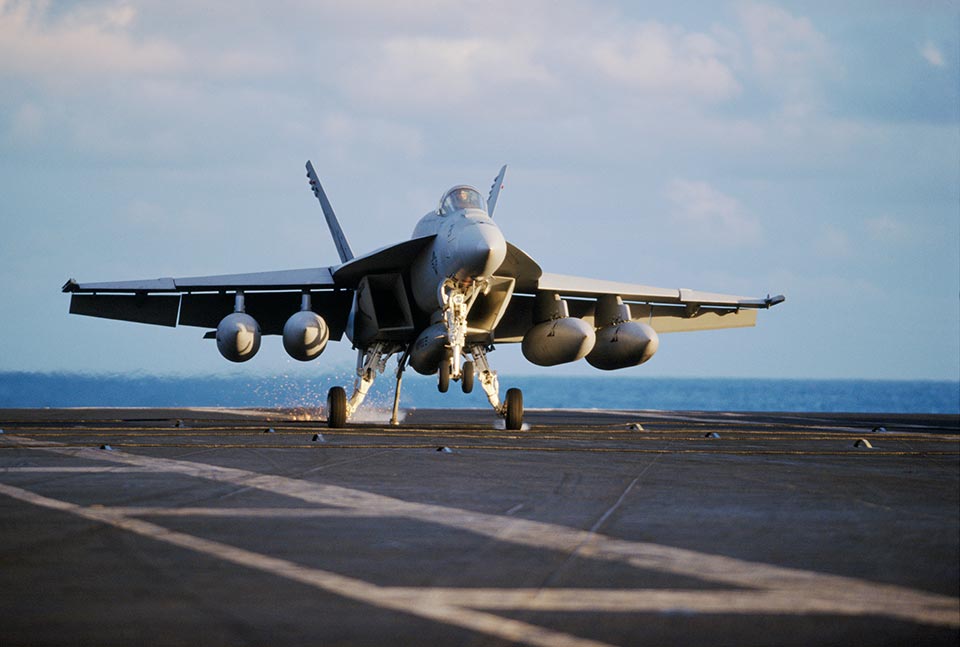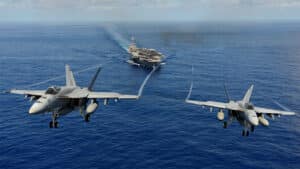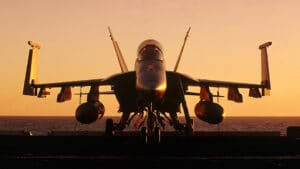Aerospace
These are some of the factors that make the Boeing FA-18 to India a likely strong contender.

The F/A-18 Super Hornet Block III on offer to the Indian Navy is the world’s most advanced, combat proven, multi-role frontline naval fighter that offers unique and differentiated capabilities and full compatibility with Indian Navy carriers.
The F/A-18E/F Block III Super Hornet was designed as a carrier-based fighter for high-load, high-stress operations. It requires little support equipment and has the lowest cost per flight hour to operate with high mission readiness rates. The Block III Super Hornet, being the US Navy’s frontline fighter with over 700 aircraft in service across the world, provides prospects for naval aviation cooperation between the US and Indian militaries. Because it interfaces with assets like the P-8I, the F/A-18E/F Block III Super Hornet can operate as a force multiplier for the Indian Navy.
- COMPATIBILITY OF CARRIER
Both INS Vikramaditya and INS Vikrant are fully compliant.
For carrier lift fitting, a safe and reliable wing-fold option is available.
On deployment, there is no risk of structures (Radome Cone, Wing Tip Rails) being removed.
- INTEROPERABILITY
P-8I interface and other U.S.-origin helicopters, as well as future carrier-based unmanned systems, are enabled by advanced network architecture.
Who will win the Indian Navy’s new fighter jet contract? F/A 18 or Rafale
- VALUE FOR TWO SEATS
The two-seater model is suitable for carrier sorties, as well as land-based missions and training.The Super Hornet is available in single and two-seater versions to the Indian Navy. The two-seater configuration, in particular, will provide the Indian Navy with several distinct advantages, including the ability to meet all missions ashore and on the carrier, increased fleet utilisation, and the ability to successfully complete those missions from the carrier that benefit from having a second crew. Two-seater carrier compatible aircraft will aid the interface between manned and unmanned systems in a carrier environment as the Indian Navy introduces unmanned carrier borne platforms.
- COOPERATION IN NAVAL AVIATION
There are 11 active aircraft carriers, with 700+ F/A-18s. Growlers and Super Hornets in action Opportunities for carrier integration, training, and technology transfer through collaboration. The Indian Navy’s introduction of the F/A-18 Super Hornet would considerably boost naval aviation cooperation, sharing of operational best practises, and interoperability between the two navies, as the US Navy operates over 700 F/A-18 Super Hornets and Growlers. The F/A-18 Super Hornet has the potential to foster collaboration between the two navies in areas such as carrier integration, training, and technology transfer, among other things.
- INDIA FOR INDIA’S SUSTAINABILITY
Optimize India Services expertise to boost mission readiness, availability, and competitive lifecycle costs by leveraging scale and efficiency with the common LCA Tejas engine family.
What is the Boeing P-8I in the Indian Navy used for?
- SKI-JUMP LAUNCH
Boeing and the US Navy demonstrated the F/A-18 Super Hornet’s ability to operate off a “ski jump” ramp in December 2020, confirming the aircraft’s potential for India’s aircraft carriers. The experiments, which took place at Naval Air Station Patuxent River, MD, demonstrated that the Super Hornet would work well with the Indian Navy’s Short Takeoff but Arrested Recovery (STOBAR) technology and backed up previous Boeing simulations.
Mind blowing facts about US Navy F/A 18 super Hornet fighter jet
- 10,000- HOUR LIFE SPAN
The airframe has a 10,000-hour life span. This means it has a long lifecycle built in for future upgrades and enhancements, and depending on the Indian Navy’s needs, our ‘By India – For India’ sustainment programme, which is based on other successful sustainment programmes that Boeing is currently executing for the Indian Air Force and the Indian Navy, will enable India to develop capabilities to sustain the F/A-18 Super Hornet.
Boeing signs pact to make F/A-18 Super Hornet fighter jets in India

Aerospace
Which is bigger 777x or 787 aircraft ?

The 777X is a new series of the Boeing 777 family and is designed to be larger and more efficient than its predecessor. It features two variants: the 777-8 and the 777-9, being the larger of the two.
The Boeing 777X emerges as the larger sibling within the Boeing family, representing a significant leap forward in both size and efficiency. Comprising two variants, the 777-8 and the 777-9, the latter takes the crown as the larger of the two. With its expansive fuselage and impressive wingspan, the 777X is tailored for long-range journeys and boasts a substantial passenger capacity.
On the other hand, the Boeing 787, affectionately known as the Dreamliner, occupies a niche in the market as a smaller yet formidable aircraft designed for medium to long-range flights. Its distinguishing feature lies in its composite fuselage, a technological marvel that renders it lighter and more fuel-efficient compared to conventional aluminum counterparts. The Boeing 777X is larger than the Boeing 787 aircraft.
When it comes to passenger capacity, the 777-9 reigns supreme, typically accommodating a sizeable contingent of 400-425 passengers in its standard configuration. In contrast, the 787, with its more modest dimensions, typically carries between 240-290 passengers, depending on the variant and layout.
One of the remarkable innovations introduced with the 777X is its folding wingtips, a feature designed to address the logistical challenges of accommodating such a large aircraft in conventional airport gates. These folding wingtips enable the 777X to retract its wings, allowing it to fit into gates designed for smaller aircraft while still reaping the benefits of an extended wingspan during flight, thereby enhancing fuel efficiency and operational flexibility
Aerospace
China Secures Production Certificate for Mass Production of Pilotless eVTOL Aircraft

The first passenger-carrying pilotless electric vertical takeoff and landing (eVTOL) aircraft in the world, the EH216-S, has received the Production Certificate for its eVTOL aircraft from the Civil Aviation Administration of China (CAAC).
This is a significant milestone for EHang Holdings Limited, the leading UAM technology platform company in the world. This outstanding accomplishment is another big step towards mass manufacturing for the eVTOL aircraft and the ensuing commercial operations, building on the ground-breaking acquisition of the Type Certificate and the Standard Airworthiness Certificate for the EH216-S.
The PC is a crucial certificate that the aircraft maker receives from the CAAC, the country’s aviation authority. By obtaining this certificate, EHang has demonstrated that it has set up a quality management system for mass production that satisfies the airworthiness regulation standards set forth by the CAAC, and the company has been given permission to continue producing mass quantities.
It is also a strong guarantee of the calibre of the goods made by EHang. Raw materials, supplier management, manufacturing organisation, production quality control, aircraft pre-delivery test, after-sales repair and maintenance, etc. are all included in the mass production quality management system for the EH216-S.
To ensure that every aircraft and its components that roll off the production line strictly adhere to the approved type design and safety requirements, the system sets clear guidelines and documentation for every step in the production procedure. This ensures comprehensive traceability and safety control.
Aerospace
Four Airbus A380 Superjumbos lined up to be scrapped

In a strategic move aimed at reclaiming valuable resources from the iconic Airbus A380 aircraft, VAS Aero Services and Dr. Peters Group have announced a significant collaboration.
This partnership marks a milestone in aviation logistics and aftermarket services, with four of these colossal planes slated for teardown and redistribution of used serviceable material (USM).
The venture between VAS Aero Services, renowned for its expertise in aircraft dismantlement, and Dr. Peters Group, a prominent Germany-based investment fund management firm, underscores a commitment to sustainable aviation practices. This isn’t their first foray into scrapping A380s; their successful partnership has already seen the dismantlement of these aircraft, making them pioneers in this niche.
Under the agreement, the latest consignment brings the tally to eight A380s entrusted to VAS by Dr. Peters Group. Managing Director Christian Mailly of Dr. Peters Group emphasized the trust placed in VAS, citing their unparalleled capabilities in dismantlement and aftermarket sales network. It’s a strategic move in response to the growing demand for quality USM parts, particularly with the resurgence in reliance on the A380.
Notably, the teardown process will be carried out at various locations, optimizing the positioning of harvested parts to cater to different markets. While some parts will be positioned in Europe to support operators in the region and the Middle East, others will remain in the Asia-Pacific region. This meticulous strategy ensures efficient access to spare parts, benefiting MROs and airlines across these markets.
The decision to retire these A380s comes at a time when operators are reassessing fleet strategies amidst evolving market dynamics. Despite initial plans for quick retirement due to the emergence of more fuel-efficient alternatives, factors such as a rebound in long-haul demand and delays in new widebody deliveries have prompted operators to reconsider. The A380, with its unique capacity and capabilities, presents a practical solution for short-term capacity management.

























